‘Tom Cruise had made a contract with the hidden forces, whatever they turned out to be’
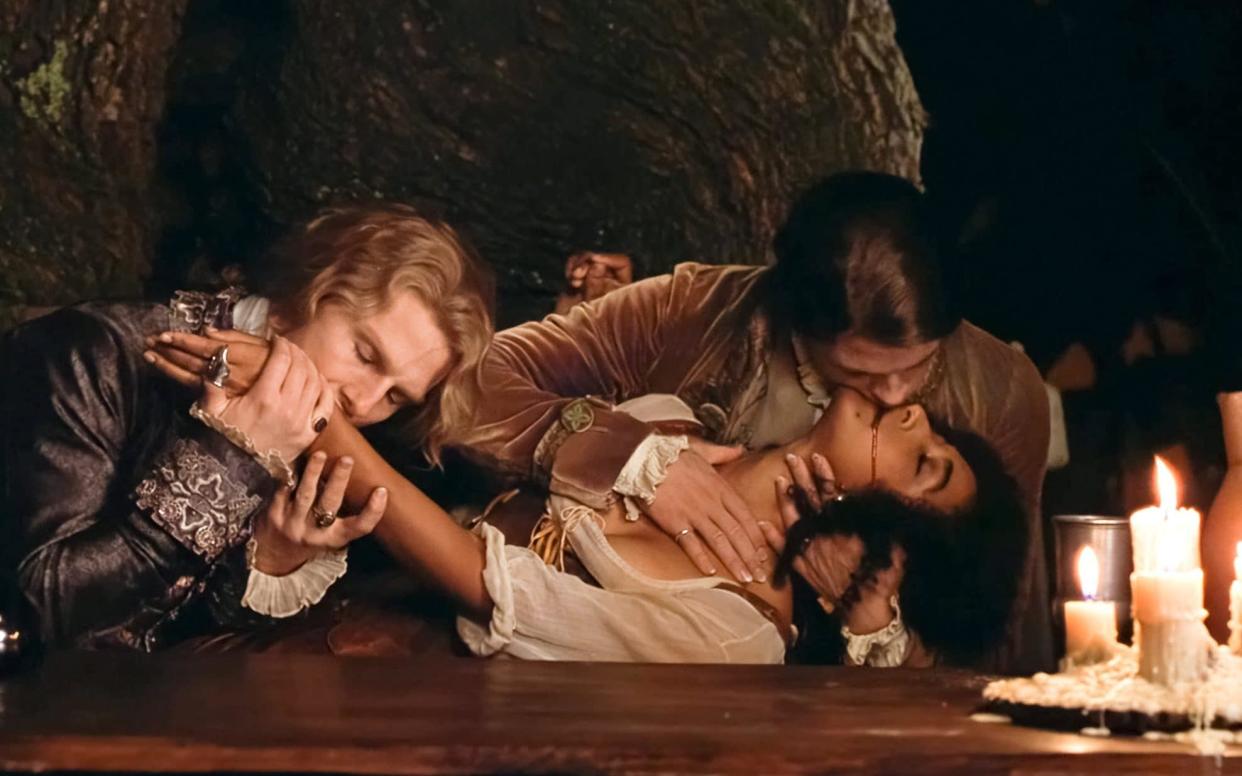
This story, like my 1994 film Interview with the Vampire, begins and ends with the Golden Gate Bridge, over San Francisco Bay. I had been offered the film by the producer David Geffen, who had been trying to shoot the book by Anne Rice for nearly 20 years. He had a script by Anne herself, which was rich and gothic and extravagant but lacked so much of the book she had written. She called me to persuade me to do it, and in the course of the phone call told me that I had directed Lestat’s favourite movie, The Company of Wolves (1984).
I was intrigued by this author who regarded her creation as a living creature, with favourite films, books and rock ’n’ roll songs. So I read the novel again and was immediately entranced. By the atmosphere that you could almost inhale. By the saga of drenched, Catholic guilt that pervaded everything. By the curse of eternal life that the vampire Lestat had visited on his chosen one, Louis. By Claudia, the daughter they had turned in order to complete their vampiric family. It had everything, really, so much of human life seen through a cracked, metaphorical mirror; everything except what you would call a story.
It was the worst kind of narrative for a film, a picaresque one. Lestat gives Louis the gift of eternal life and they bitch together, through the centuries. Still, if I could make the themes resonate, of the loss of innocence and light, it could possibly be a vampire film like no other.
I asked David could I try my own hand at the script, and he said yes. I began and it almost wrote itself, so quickly I was embarrassed to tell David and Warners that I had finished. But I had to hand it over eventually, and they liked it so much they put it into immediate production. I was wary of studios, Hollywood, the demands of a huge and expensive production. I had been there before, and knew I worked best with an independent palette. I explained my concerns to David, and he made me an extraordinary promise. That whatever the budget, whatever the cast, whatever the scale of the film we would make, he would ensure I made it without interference, as an independent production. It was an offer I couldn’t refuse, from a man who always kept his word.
The problem was the casting of Lestat. Brad Pitt had agreed to play Louis and somehow assumed Daniel Day-Lewis would be playing Lestat, an assumption shared by Anne. I offered it to Daniel, who read it, and, as I expected, didn’t want to play the character. A few years before, he had confined himself to a wheelchair to play Christy Brown in My Left Foot. He would have had to sleep in a coffin for the entirety of this production if he followed the same practice. So we moved on.
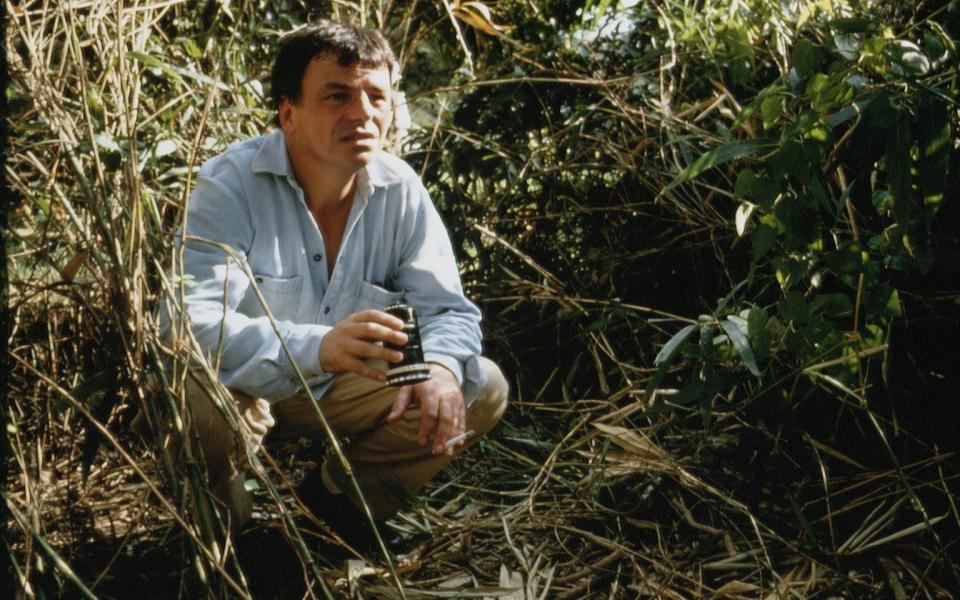
David asked me if I wanted to meet Tom Cruise. Now, a meeting like that is a kind of a trap. You can’t really say no to the biggest star in the universe. So if you agree to meet, it says something. If you refuse to meet, it says something else. But I had always loved his performances, that cool commitment with which he held the centre of whatever picture he was in, from The Outsiders (1983) onwards.
And anyway, what on earth was a star? So I drove out to the rather unshowy house he had in Brentwood, and met one. My first impression was of a rather chilled, and again unshowy, perfection. I was buzzed in through a small, gated entrance. Waited on a terrace while an unshowy assistant poured me a glass of cold water. The assistant wore jeans and a white T-shirt, had one of those leather belts with a bumbag round his waist. Who knows what was inside it. Then Tom entered, again in jeans and a white T-shirt, but without the belted bag. Anything he needed would come from the assistant’s bag.
He had the script, his lines outlined in a yellow or green felt pen, the way actors do. I could never work out whether that was an aide-memoire or a guide to how much their part would occupy in the finished picture. But he seemed fascinated by the character, the strength, the absence of any moral compass whatsoever. As we talked, I remembered something that Sean Penn had told me. Of all the young roustabouts of his generation, Cruise was the toughest, would never back down. I couldn’t quite get that picture from the preternaturally polite young man beside me, but there was something. There was something eerily self-made even about his physique, his evident fitness. He hadn’t got the body of an athlete. But he was an athlete. In any competition he had entered, there was no doubt whatsoever that he would win.
I left him with a strange feeling. I wasn’t sure. Neither, evidently, was he. But I was unsettled. As, it turned out, was he. Because I got a call from David Geffen that night asking me to go back for another meeting. Tom evidently worked behind the scenes. In that strange ether where things are decided. Clipped phone calls, curt messages, polite exchanges in a freemasonry that worked out what was what. And then I understood.
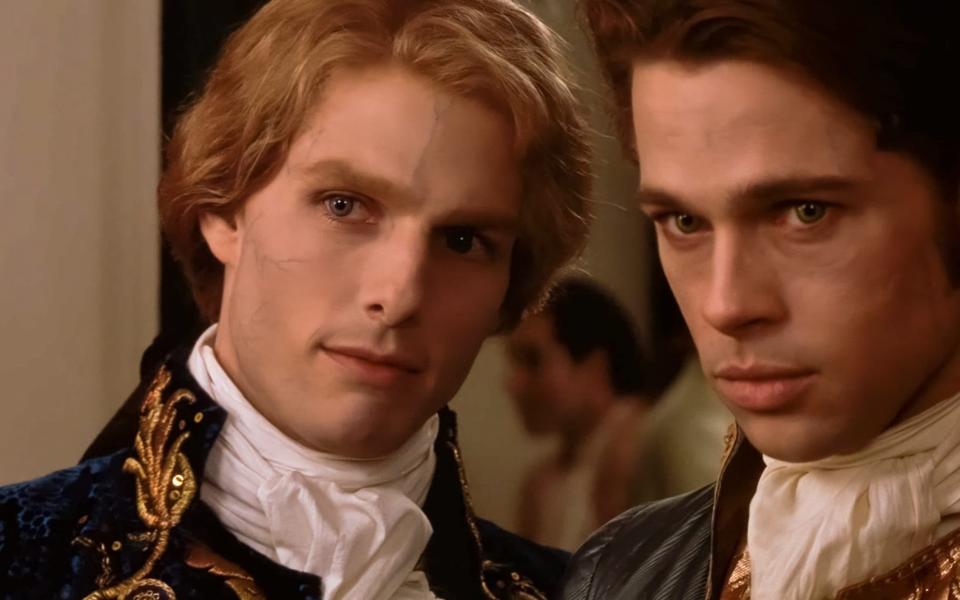
In a subsequent novel, without much of the power of her first, Anne Rice had placed Lestat in Hollywood. In a gated mansion, down a discreet drive. He wasn’t an actor, in this iteration, although he could have been. He was a rock ’n’ roll star.
I drove back out to Brentwood, back through the gated entrance. Sat down on the same terrace, to be given another bottled water by the same assistant. I was told Tom was out on a bike ride. I looked out on the hilly expanse around and had an image of him ascending them effortlessly, without any expense of sweat whatsoever. I was happy to wait. Because I finally got it. He had to live a life removed from the gaze of others. He had made a contract with the hidden forces, whatever they turned out to be. He had to hide in the shadows, even in the Hollywood sunlight. He would be eternally young. He was a star. He could well be Lestat.
He was also a superb actor, but that small fact got lost in the outrage that followed. Half of America, it seemed, had read Anne Rice’s books and wanted a say in the casting of Lestat. Anne herself took to the airwaves, saying that it was as if I had cast Edward G Robinson as Rhett Butler. But she was wrong and was later big enough to admit it. I met a goth girl in a bar in New Orleans who insisted on showing me a tattoo on her butt of Rutger Hauer as Lestat. She was wrong, too. They were all wrong.
Brad Pitt was upset, but too much of a gentleman to make an issue of it. But the passivity of Louis got him down, the unrelenting darkness. We shot for months in New Orleans, always at night. And now I was on the Golden Gate Bridge in San Francisco, again at night, trying to work out how to begin and end the film, when the chief of police roared up on a motorbike.
You’re Irish, I’m Irish, he said. He wasn’t, he was as American as the Harley he was riding, but I knew what he meant.
Anything you want in this city, just let me know.
And actually, oddly enough, there was. I remembered two of my father’s cousins, from another bridge, over the Nanny river in Laytown, Ireland. Probably with fishing rods in their hands. Walking the oozing mud in bare feet, trousers rolled up around their ankles. Both devilishly handsome, dark-haired, a kind of Gene Kelly version of what my own father could have been. One of them was a priest, a monsignor, actually, and impossibly glamorous.
The term monsignor was one I didn’t fully understand as a child, but I knew it was in a different category from the dandruff-fringed parish priest who said Mass in the old church down from the Nanny. The monsignor had a gold cigarette lighter, which he displayed on the putting green, and wore not that housekeeper’s funereal dress thing that most priests wore, but a close-fitting black suit that could have been worn by Frank Sinatra. More hair than Sinatra, dark, Vaselined backwards so you could see the grid the comb threads had left. I’m sure he had a good handicap, too, although golf was never my thing.
He had gone to South America, I had heard, and in the ferment of liberation theology had left the priesthood and married – was it a nun? I could imagine them both in green fatigues with Kalashnikovs swung over their shoulders, him barely sweating in the torrid jungle, pausing by a tamarind tree, pulling out a pack of Lucky Strikes and offering one to her and lighting his and hers with – what else? – the same gold cigarette lighter.
Anyway, I had an uncle who was a monsignor, who left the Church for some reason in South America, whose name was Jimmy or Peadar Kearns, and I was on the Golden Gate Bridge preparing for the opening and closing shots of Interview with the Vampire. We had to close off one section of the bridge, so Tom Cruise could drive over it having drunk the blood of Christian Slater, and the chief of police of the San Francisco area is beside me on his Harley-Davidson. It is the first time the bridge has been closed, even in part, for any kind of motion-picture shoot and it is a very big deal. He asks me again. Anything he can do to help, over the few days I’m in town.
And that’s when I remember the monsignor. He had retired, I had been told, from the jungles of Ecuador, or from the streets of Quito, probably to a seminary, converted into a social-housing project (with or without the nun? I had no idea) and was now running a bar in the Tenderloin district of San Francisco. And even the name Tenderloin had that odd hint of glamour – or was it danger? – that the gold cigarette lighter brought with it and the imagined Ecuadorean jungle.
So this kindly, white-haired chief of police on his Harley, on the Golden Gate Bridge, takes down my phone number, with his notes. Ex-monsignor. Bar. Tenderloin. Give me 24 hours.
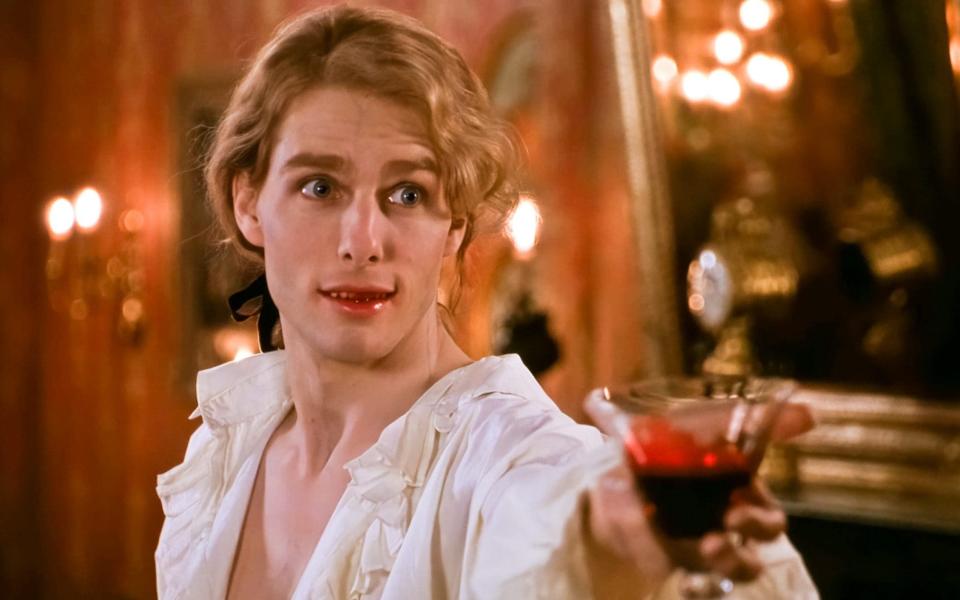
I shot the scene the next night. Christian Slater (as Malloy) drives over the moonlit bridge, in an open-topped car. He places the tape of his interview in the deck, presses play and hears Brad Pitt’s voice come over the speakers.
Most of all I longed for death...
A hand grabs the interviewer’s neck, pulls him flat. Lestat, of course, who sinks his teeth in. Takes the wheel.
Oh, Louis, Louis, still whining, Louis. Have you heard enough? I’ve had to listen to that for centuries.
And it was odd, in the end, the way the actors’ approach to their roles mirrored the roles themselves. Louis, the reluctant vampire, played by Brad, the reluctant actor.
He had a hard time. Forgive me, Brad.
Lestat, who toys with that very reluctance, played by Tom, who never let a part defeat him.
As the producer Stephen Woolley put it, it was like having Elvis and Frank Sinatra in the same film.
I go back to my hotel room. Sleep, always like a vampire, through the day.
A phone call wakes me up. It is the chief of police, within the requisite 24 hours. He gets immediately to the point.
Ex-monsignor. Runs a bar. Tenderloin and downtown San Francisco environs.
I’ve found 17, he tells me.
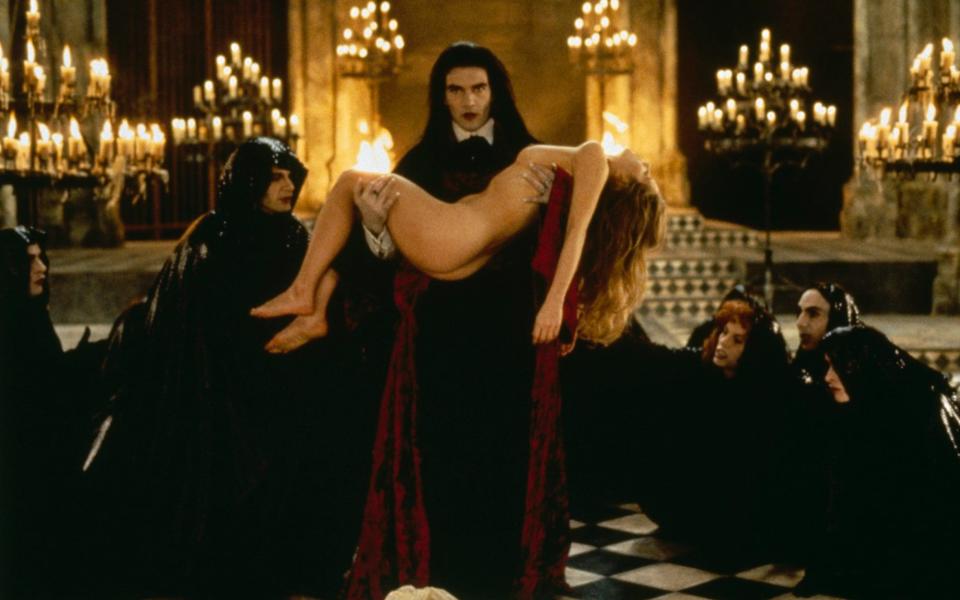
Now, I’m sure not all of them looked like Frank Sinatra, carried a gold cigarette lighter, married a nun after getting swept away by the heady winds of liberation theology, but one of them would have to be him. So, the chief of police began to make inquiries. And one Friday evening – I was due to leave, I remember, on the Saturday – he told me that an ageing cleric, who had the key to this diaspora, would be calling me. So the phone rang and a voice out of the more realistic memories of my childhood came on. It had lost none of its West of Ireland rise and fall of complaint. I was back behind a desk in a Christian Brothers school, my bare knees banging off the screws underneath. Because I recognised that voice. It had nothing to do with gold cigarette lighters, or close-fitting Frank Sinatra suits. It wore a soutane and had a leather concealed in the inner folds of the swishing black serge.
Who are you inquiring about? it asked.
My uncle, I replied. Peadar or Jimmy Kearns.
And why?
He’s an ex-priest, I told him. Or an ex-monsignor. He runs a bar in San Francisco. One, I have been told, among 17.
There was another pause. He was the keeper of secrets, this old gentleman, and I had to assure him I was looking for none of them. I was making a film in San Francisco and just wanted to reacquaint myself with a piece of my more innocent childhood.
Where’s he from?
Roscommon.
Where in Roscommon?
And I had to rack my brains. Boyle, I remembered, was where my father was born. But maybe not the Kearnses. And suddenly a name popped into my head. A kind of Grecian name, with a tincture of myth to it. Something to do with elves. Much more romantic than Boyle.
Elphin?
And even the name triggered some kind of release. He exhaled, gave me the address of a Tenderloin bar.
I had to leave the next lunchtime. Take a plane back to Los Angeles. But I had the car swing by the bar, in the early morning. Entered one of those working-class watering holes, where a young kid was swabbing the counter amid last night’s beer fumes. I asked for Peadar Kearns. Or was the name Jimmy?
Mister Kearns, I was told, was away for the weekend, would be back on Monday.
Does he, I asked the kid, still have a gold cigarette lighter? He looked confused. You want a light? he asked. No smoking in here.
I had so many questions. Does he still look like Frank Sinatra in a clerical collar? Did he wander the jungles of Ecuador in an outfit like Che Guevara?
And what about Elphin? Were there elves there? And by the way, were there tender loins in the Tenderloin?
So many questions, but the car was waiting. We were shooting in London next.
So I left a note and drove back over the Golden Gate Bridge to the airport.
This is an edited extract from Amnesiac, by Neil Jordan (Apollo, £25), to be published on June 20


